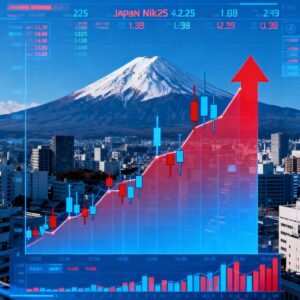Japan Nikkei 225 Index 2025: Record Highs, Market Trends & Investment Insights
The information gathered provides a comprehensive and up-to-date view on the Japan Nikkei index, particularly the Nikkei 225, with data and recent events of October 2025.
I will now proceed to write a complete SEO-friendly article on the Japan Nikkei Index, ensuring detailed and accurate coverage of its history, recent performance, significance, and outlook with over 1500 words.Japan Nikkei Index: A Comprehensive Guide to Japan’s Leading Stock Market Barometer

The Japan Nikkei index, commonly referred to as the Nikkei 225, stands as the premier stock market index for the Japanese stock market and serves as a vital economic barometer of Japan’s economy. In 2025, the Nikkei 225 has been making headlines worldwide with record-breaking performances and significant market movements. This article provides an in-depth, SEO-friendly guide to the Nikkei index, covering its history, composition, recent performance, impact, and future outlook to equip investors, analysts, and enthusiasts with a thorough understanding of Japan’s leading equity index.
What is the Nikkei 225 Index?
The Nikkei 225, often simply called the Nikkei, is a stock market index that tracks the performance of 225 large, publicly-traded companies listed on the Tokyo Stock Exchange (TSE). It is a price-weighted index, meaning companies with higher stock prices have a greater impact on the index’s movement than those with lower prices, similar to the Dow Jones Industrial Average in the United States.
The index was first calculated on September 7, 1950, with an official base value dating back to May 16, 1949, at 176.21 points. Since then, it has grown into the most widely quoted and tracked stock index in Japan, reflecting market sentiment, economic conditions, and corporate performance across a broad range of sectors.
Historical Context and Significance
The Nikkei 225 has had a dramatic history that mirrors Japan’s economic transformations. During Japan’s post-war economic boom, the index rose steadily, culminating in an extraordinary bubble era in the late 1980s. On December 29, 1989, the Nikkei reached its historical intraday peak of 38,957.44 points—a high that stood unchallenged for over three decades.
However, the bubble burst in the early 1990s, leading to a prolonged economic stagnation known as the “Lost Decade.” The index plummeted, reaching a post-bubble low of 6,994.90 in October 2008 amidst the global financial crisis.
Recently, the Nikkei has regained momentum, with a remarkable resurgence that culminated in surpassing the 46,000 points barrier for the first time ever in October 2025, and hitting new record highs above 47,900 points. This historic rally marked the highest level since the 1989 peak and signaled renewed investor optimism in Japan’s economy and markets.
Composition and Calculation
The Nikkei consists of 225 top-rated companies listed in the First Section of the TSE, representing diversified sectors such as technology, automotive, finance, consumer goods, and manufacturing. Some of the prominent companies include Toyota, Sony, SoftBank Group, Mitsubishi, and Tokyo Electron.
As a price-weighted index, the calculation involves taking the sum of the prices of all 225 stocks divided by a divisor, which is adjusted for corporate actions such as stock splits and dividends to maintain continuity. The index is updated every five seconds during market hours, providing near real-time insights into market dynamics.
Recent Performance and Market Drivers in 2025
October 2025 has been a landmark month for the Nikkei 225. The index surged more than 4% on October 6, 2025—reaching around 47,600 points—after significant political developments in Japan’s ruling Liberal Democratic Party (LDP).
The election of Sanae Takaichi as the new LDP leader, who is projected to become Japan’s first female prime minister, fueled market optimism. Takaichi is known for her pro-stimulus fiscal policies, aligned with the late Shinzo Abe’s “Abenomics” approach, which combines aggressive monetary easing, fiscal stimulus, and structural reforms to boost Japan’s economy.
Following her election, sectors like real estate, technology, and consumer discretionary led the rally. Notable stock price gains included Japan Steel Works (+13%), Mitsubishi Heavy Industries (+11%), and Kawasaki Industries (+10.5%). Technology giants such as Advantest, Disco Corp, Tokyo Electron, and SoftBank Group also recorded significant advances ranging from 2.8% to 6%.
The Topix index, a broader market index of all TSE First Section stocks, also climbed over 3% to a new all-time high, signaling widespread positive sentiment in Japan’s equity markets.
Economic and Monetary Context
The market enthusiasm is supported by expectations that the Bank of Japan (BOJ) will continue its accommodative monetary policy stance. Analysts anticipate that Takaichi’s government will encourage the BOJ to maintain or slightly adjust its policy, possibly including a modest 25-basis-point interest rate hike by early 2026 to manage inflation pressures while supporting growth.
The yen weakened against the U.S. dollar, trading around 149.6 yen per dollar, reflecting expectations of continued fiscal expansion that may increase inflation. Meanwhile, Japanese government bond yields, especially the long-term 30-year bond, risen above 3.2%, showing changing market perceptions of risk and growth prospects.
Nikkei’s Global Impact and Investment Importance
As Japan is the world’s third-largest economy and a major hub for technology, automotive, and industrial sectors, the Nikkei 225 serves as a critical indicator for global investors. Movements in the index influence investor sentiment not only in Asia but across global financial markets, affecting portfolio allocations, exchange rates, and international trade dynamics.
Investors use the Nikkei to gauge Japan’s economic health, which in turn impacts multinational corporations, supply chains, and commodity markets. Additionally, the Nikkei 225 futures contracts traded on exchanges such as the Singapore Exchange (SGX) and Chicago Mercantile Exchange (CME) offer investors globally accessible instruments to speculate or hedge exposure to Japanese equities.
Investing in the Nikkei 225
Investors interested in the Nikkei 225 can access the index through various vehicles including exchange-traded funds (ETFs), mutual funds, futures contracts, and derivatives. These financial instruments provide exposure to Japan’s top companies, allowing diversification and participation in one of Asia’s most dynamic markets.
Given its price-weighted nature, investors should be aware that the index is more sensitive to price changes in higher-priced stocks, which may impact the overall index movements differently compared to market capitalization-weighted indices.
Outlook and Future Trends
The outlook for the Nikkei 225 remains cautiously optimistic. The combination of proactive fiscal policies under new leadership, supportive central bank actions, and strong corporate earnings underpin positive near-term prospects.
That said, challenges such as global economic uncertainties, trade tensions, demographic shifts in Japan, and currency volatility may introduce risks.
Analysts expect the Nikkei to maintain higher levels with possible corrections, forecasting the index to trade around 44,000-48,000 points over the next 12 months, reflecting balanced growth potential alongside market volatility.
Conclusion
The Japan Nikkei 225 index is much more than just a number — it embodies the story of Japan’s economic rise, challenges, and resurgence. The recent historic surge in 2025, driven by significant political developments and economic policies, has reaffirmed the Nikkei as a critical gauge of market and economic health.
For investors and analysts, understanding the Nikkei’s history, structure, and current dynamics is crucial in navigating not only Japan’s markets but also the broader global financial landscape. With ongoing reforms and monetary support, the Nikkei 225 stands as a beacon of opportunity reflecting the resilience and innovation of Japan’s economy in 2025 and beyond.







